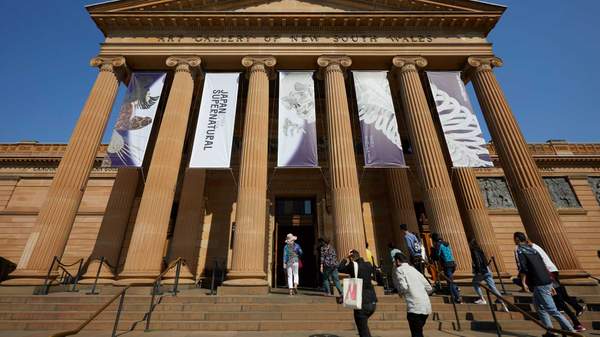Overview
Blending the work of a modern-day superstar and some of Japan's most renowned historical artists, Japan Supernatural is the Art Gallery of New South Wales' latest blockbuster exhibition. The exhibition features 180 works drawn from collections around the world — an eclectic mix of paintings, traditional woodblock prints, animation work and sculptures — which each delve into the Japanese folktales that continue to influence pop-culture today.
The exhibition's headline act is contemporary artist Takashi Murakami, a dazzling spectacle of an artist that shines almost as bright as his massive works of art. Famous for his paintings and sculptures that incorporate motifs from both traditional and popular Japanese culture, at Japan Supernatural, Murakami debuts an enormous ten-metre-wide mural that depicts folk stories, anime characters and a litter of other cultural references.
Running until March 8, 2020, the exhibition features work by other modern-day legends, such as the late manga artist Mizuki Shigeru and contemporary artist Taro Yamamoto. Meanwhile, there are also works by seminal artists from a bygone age, including Katsushika Hokusai, Utagawa Kuniyoshi, Tsukioka Yoshitoshi and Kawanabe Kyosai.
Presented as part of the 2019–20 Sydney International Art Series, Japan Supernatural also includes an array of public events. Just some of the special happenings on offer include a rare lecture by Murakami, a retrospective of global horror cinema, a festival showcasing beloved Studio Ghibli films and a Japanese summer art school. With so many ways to explore the AGNSW's newest exhibition, don't miss your chance to discover the stories and magical creatures behind Japan Supernatural.
An installation view of the exhibition Japan Supernatural at the Art Gallery of New South Wales. Photo: AGNSW/Jenni Carter.
TAKASHI MURAKAMI: JAPAN SUPERNATURAL
The full title of Murakami's mural, Japan Supernatural: Vertiginous After Staring at the Empty World Too Intensely, I Found Myself Trapped in the Realm of Lurking Ghosts and Monsters, is quite the mouthful. But you'll likely find your mouth agape once you set your eyes upon this huge undertaking.
Stretching ten-metres wide and three high, the colourful mural features an arrangement of various images drawn from ukiyo-e prints, which were reproduced by Murakami's 350 employees back at his bustling studio in Tokyo. Made from 502 silkscreens, Japan Supernatural is the largest single work to enter the gallery's international collection, which depicts demons from Japanese folklore battling it out with samurai beneath the spirit of a massive cat.
KENTARO YOSHIDA: NIGHT PROCESSION OF THE HUNDRED DEMONS
The first work you'll encounter as you arrive at Japan Supernatural is that of Sydney-based artist and illustrator, Kentaro Yoshida. Born in a small fishing village in Japan, Yoshida heard many of Japan's popular folk stories as a child, learning about a world of ghosts, spirits and demons. His mural takes inspiration from these tales, specifically the centuries-old legend Night procession of the hundred demons (Hyakki Yagyō). It was created in four sections and positioned at the gallery's entrance court — if you download the Artivive app (via Apple or Google Play), you can experience the stunning creation with an augmented reality twist.
'Mitsukuni defies the skeleton spectre conjured up by Princess Takiyasha' 1845–46 by Utagawa Kuniyoshi, British Museum, donated by American Friends of the British Museum from
the collection of Prof Arthur R Miller. Photo: © The Trustees of the British Museum
UTAGAWA KUNIYOSHI: MITSUKUNI DEFIES THE SKELETON SPECTRE CONJURED UP BY PRINCESS TAKIYASHA
Considered one of the last masters of ukiyo-e printing and painting, Utagawa Kuniyoshi was also known for being incredibly prolific. Throughout his expansive career during the 19th-century, Kuniyoshi created some of the style's most popular prints featuring everything from warriors and ghosts to satire and erotica. Loaned from the British Museum, one of Kuniyoshi's celebrated works, Mitsukuni defies the skeleton spectre conjured up by Princess Takiyasha, is a striking triptych woodblock print telling a well-known tale about revenge. Kuniyoshi's art fell from relevance for many years until it was rediscovered in the 1920s, with his work going on to become some of the best known from the Edo period.
TSUKIOKA YOSHITOSHI: NEW FORMS OF THIRTY-SIX GHOSTS
Published between 1889 and 1892, New forms of thirty-six ghosts is perhaps Tsukioka Yoshitoshi's most acclaimed series. Highlighting numerous characters from ancient Japanese and Chinese folktales, it was also the final major woodblock collection he would ever produce. Having lived through many years of Japanese societal uncertainty, Yoshitoshi's work often focused on violence and conflict. But later in his career, his prints became much more reflective, capturing some of his own personal struggles. With this series drawn from the AGNSW's own collection of Japanese art, Yoshitoshi is often credited as the godfather of contemporary manga and anime.
UTAGAWA YOSHITSUYA: SHUTEN-DOJI AT OEYAMA
Utagawa Kuniyoshi was responsible for tutoring many of Japan's greatest woodblock artists, but few were as special as Utagawa Yoshitsuya. Emerging in the late Edo period, the political instability of the time led to artists being banned from illustrating performers in their work. Instead, Kuniyoshi focused on creating images of powerful warriors, as well as tattoo designs that he became famous for during the 1840s and 50s. This colour print highlights a well-known story where the popular hero Minamoto Yorimitsu slays the ogre Shuten-doji in his mountain lair at Oeyama, a part of modern-day Kyoto.
Japan Supernatural is on display at the Art Gallery of New South Wales until March 8, 2020. Head to the website to grab your tickets.
Top images: An installation view of the exhibition Japan Supernatural at the Art Gallery of New South Wales. Photo: AGNSW/Jenni Carter.
